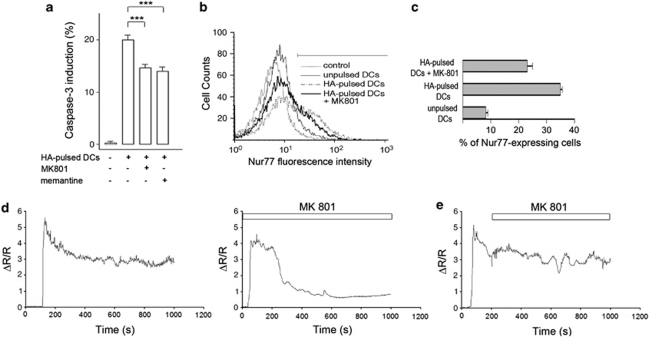Figure 3.
NMDAR triggers a sustained Ca2+ signal, is transiently activated and is involved in caspase-3 activation and Nur77 induction, in thymocyte-DC contacts. (a) Inhibition of caspase-3 (t=6 h) expression in DP thymocytes co-cultured with unpulsed or HA-pulsed DCs with or without MK801 (100 μM) and memantine (100 μM). Data are means of six replicates for five independent cultures (*** P<0.001). The effect of memantine or MK801 on apoptosis was dose-dependent and was significant at 10 μM, with the maximal effect observed at 100 μM. A dose of 10 μM MK801 resulted in 11.4±1% inhibition of apoptosis (n=6) and a transient Ca2+ signal in 50% thymocytes (n=10) (data not shown). (b) Flow cytometry analysis of Nur77 expression in DP thymocytes, before and 4 h after contact with antigen-loaded DCs, in the presence or absence of MK801 (100 μM). The graphs are representative of three experiments. (c) Quantification of Nur77-expressing DP thymocytes before and 4 h after contact with HA-loaded DCs, in the presence or absence of MK801 (100 μM). (d) Representative traces of the Ca2+ response in thymocytes in contact with HA-pulsed DCs. Thymocytes were preincubated with MK801 (100 μM), NMDA (300 μM) and -serine (20 μM) to block any NMDARs that would be present at the membrane before synapse formation. Thymocytes were then washed and added to HA-pulsed DCs in the absence or presence of the NMDAR antagonists MK801 (100 μM). (e) Representative traces of the Ca2+ response in thymocytes in contact with HA-pulsed DCs MK801 (100 μM) was applied after the beginning of Ca2+ response (t=208 s)

